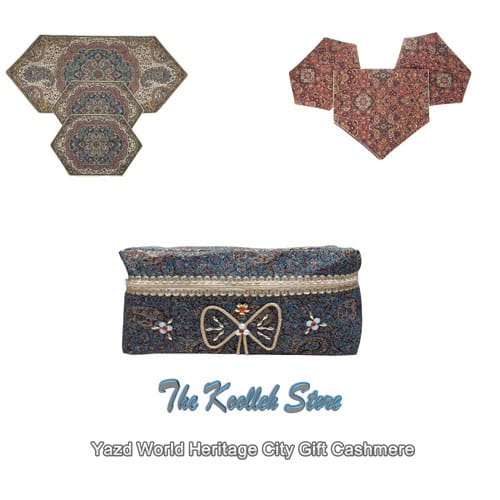Yazd World Heritage City Gift Cashmere

Handicrafts in Iran have a historical background and date back to the Middle Stone Age with more than 6,000 BC.
In Yazd province, 3,000 artists are currently working in 40 fields of handicrafts.
The magnificent and hand-woven souvenir cashmere, which is now industrialized, has always been of interest to domestic and foreign tourists and is taken to different parts of Iran and the world as a gift from the World Heritage City of Yazd.
The peak of cashmere weaving was during the reign of Shah Abbas Safavid and at the same time with the prosperity of textiles in this period, so that artists from all over the country gathered in the royal workshop in Isfahan and Ghiasuddin Naqshband Yazdi as the head of this workshop trained more than 600 artists.
Most of the artists in Yazd used to be weavers in the past, and cashmere workshops existed as luxury hand-woven in most of the old neighborhoods of this province, and often in each workshop, two artists worked together to weave cashmere.
After years of activity of weaving artists in Yazd, first gold weaving and then traditional cashmere weaving in this province became obsolete. Of course, gold weaving was recently revived with the help of experts from the Cultural Heritage Research Institute of Cultural Heritage, Handicrafts and Tourism and eight people in a specialized center. The textiles of the province are located in Baghi’s house.
Attention to speed in weaving and machine making of cashmere weaving machines, this art turned the industry from traditional and handmade to industrial, which according to the deputy of handicrafts of the General Directorate of Cultural Heritage, Handicrafts and Tourism of Yazd province is a fatal blow to this. The art of industry imported.
Deputy of Handicrafts of Yazd General Directorate of Cultural Heritage says: cashmere weaving in the current and industrialized way began about five decades ago in Yazd and due to the historical background in the textile industry, in recent years some devices in this sector, including Ihrami, Zari and Termeh were rebuilt and many workshops were established in the province’s carpentry and weaving department.
Mohammad Reza Dehghan Mehrjardi added: More than 700 people were trained in these fields, most of whom were attracted to the labor market.
He stated that cashmere is now considered as an industry in the province, adding: Of course, considering that cashmere is considered as a glorious souvenir of Yazd, we will support this industry to participate in exhibitions.
He said: Traditional fabrics and artists use this fabric as a substitute for traditional embroidery, including kohl embroidery and tapestry embroidery.
He added: We are trying to revive some cashmere weaving workshops, especially in the field of tourism, and based on this, several workshops have been restored, but achieving this important goal requires spending more money.
He continued: If the government comes to this conclusion, the revival of traditional workshops will increase the number of tourists and will definitely support this issue and allocate a suitable budget for it.
Also, one of the producers of cashmere fabric in Yazd, stating that the main material of cashmere is silk, said: Currently, cashmere with polyester and plastic, which are called counterfeit cashmere, is produced and offered at a low price.
Mohammad Ali Shahandeh added: The price of cashmere varies and depends on the number of colors and density of silk in it, which is offered from 60 thousand Rials to four million Rials per meter.
Recalling the current economic situation, he said: Considering that cashmere is not among the essential goods and needs of families, therefore, the market and the reception of its purchase has declined.
At present, cashmere fabrics are available in the machine market, its manual production is not very small and economical, and its traditional texture will only be ordered by the customer.
Cashmere is a fabric with silk thread and weave of yarn, wool, colored wool and silk, and the weaving of cashmere was done with a finger in the past, and therefore it was also known as finger weaving, but later it was done semi-by hand and for weaving. They used special devices.
Bate and Jaqeh, Shah Abbasi design and deer antler are common designs used in cashmere with different types such as shawl, Charqadi shawl, striped shawl, Atabaki shawl, Muharram shawl, Reza shawl, Kashmiri shawl and Yazdi shawl.
Yazd province, with a population of 1,138,000, has 1,720 historical and cultural monuments.
Due to the richness of Yazd in terms of historical and cultural monuments, five works including Yazd’s historical context, Dolatabad Gardens of Yazd and Pahlavanpour Mehriz and Zarch and Hassanabad aqueducts have been registered in the UNESCO World Heritage List.
Yazd is the first city of raw clay and the second historical city in the world, and along with the provinces of Fars and Isfahan, as the golden triangle of tourism in Iran, it is the first destination of foreign and European tourists.
Yazd is known as the city of windbreaks, Dar al-Abadah, Hosseinieh of Iran, bicycles, sweets, aqueducts, aqueducts, contentment and the sun.

